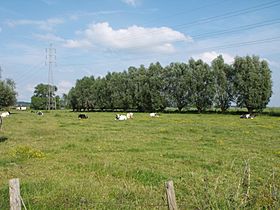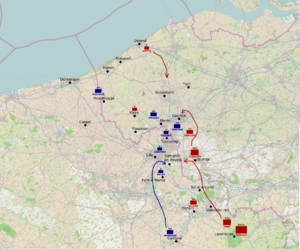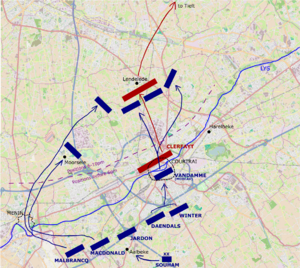Battle of Courtrai (1794) facts for kids
Quick facts for kids Battle of Courtrai (1794) |
|||||||
|---|---|---|---|---|---|---|---|
| Part of the War of the First Coalition | |||||||
 The landscape on the outskirts of Courtrai (now Kortrijk) in 2009 |
|||||||
|
|||||||
| Belligerents | |||||||
| Commanders and leaders | |||||||
| Strength | |||||||
| 60,000 | 40,000 | ||||||
| Casualties and losses | |||||||
| 1,000 | 1,500 | ||||||
The Battle of Courtrai (May 11, 1794) was a fight between the French army and a group of armies called the Coalition. The French army was led by Jean-Charles Pichegru. The Coalition forces were commanded by François Sébastien Charles Joseph de Croix, Count of Clerfayt. This battle was part of the War of the First Coalition.
The French had recently captured Courtrai (now Kortrijk) in Belgium. The Coalition wanted to take it back. On May 10, the French tried to move east towards Tournai. But the Duke of York's British troops stopped them in the Battle of Willems. The Duke of York then pulled back to Tournai. On the same day, Clerfayt attacked Courtrai from the north but didn't make much progress.
On May 11, with the Duke of York's retreat, the French turned their attention to Clerfayt at Courtrai. They forced him to retreat north. This battle helped the French keep control of Courtrai and Menin (now Menen). These towns were important for the French in their 1794 attacks in the Low Countries. Courtrai is about 85 kilometers (53 miles) west of Brussels.
Sometimes, the "Battle of Courtrai" refers to both the battle on May 11 and the Battle of Willems together. This is because they were part of the same big plan.
Contents
Why the Battle Happened: The Background
Plans for the Spring Campaign
In the spring of 1794, Lazare Carnot from the French government (the Committee of Public Safety) made a plan. He wanted the French army to attack the sides of the Coalition forces in the Austrian Netherlands. The main French general, Jean-Charles Pichegru, would lead 100,000 soldiers to attack Ypres, then Ghent, and finally Brussels.
Another 100,000 French soldiers would attack towards Liège and Namur. This was to cut off the Austrian army's way to Luxembourg City. About 50,000 French soldiers stayed in the middle of the battle line. This plan was risky because the Coalition could focus their main army on one French side and defeat it.
In March 1794, the French Army of the North had many soldiers. About 126,035 were ready to fight. General Pichegru had over 227,000 troops in total.
Coalition Forces and Their Plans
The Coalition forces were led by Prince Josias of Saxe-Coburg-Saalfeld. In April 1794, their armies were spread out. General Clerfayt commanded about 24,000 Austrian, Hanoverian, and Hessian soldiers. They were in charge of defending towns like Menin and Ypres.
The Duke of York had 22,000 troops near Saint-Amand-les-Eaux. Prince Coburg, the main commander, had 43,000 men near Valenciennes. Other forces included Dutch soldiers and more Austrians. On April 17, Coburg's main army attacked the fortress of Landrecies. The siege ended on April 30 when the French surrendered.
The Battle of Mouscron
On April 26, Coalition cavalry attacked a French group trying to help Landrecies. The French lost 7,000 soldiers. Their commander, René-Bernard Chapuy, was captured. Pichegru's secret plans for attacking Flanders were also found.
Meanwhile, the French attacked other Coalition troops. On April 24, French divisions moved towards Nieuport, Ypres, Menin, and Courtrai. General Joseph Souham's division captured Courtrai. With Pichegru's plans, Coburg sent more soldiers to help Clerfayt. But it was too late. Souham defeated Clerfayt in the Battle of Mouscron on April 29. The Coalition lost 2,000 soldiers and 23 cannons. The next night, the Coalition army left Menin.
The Allied Counterattack Begins

After Landrecies fell, Coburg sent the Duke of York's troops to Tournai. Heavy rains slowed them down. By May 3, York's forces joined up with others near Tournai. York had about 18,000 soldiers, Clerfayt had 19,000, and another general, Johann Ludwig, Reichsgraf von Wallmoden-Gimborn, had 4,000-6,000 men.
On May 5, the Allied commanders made a plan. Clerfayt would cross the Lys River and attack Courtrai from the north. At the same time, York would move west from Tournai. This was to cut off Courtrai from the French base at Lille. Clerfayt was slow to move until he got direct orders.
York thought the French had about 24,000 soldiers in the area. But the French actually had 40,000 to 50,000 soldiers between Menin and Courtrai. Pichegru also ordered 20,000 more soldiers to move closer to Lille. Coburg sent more divisions to Tournai to help. He ordered Clerfayt to attack Courtrai. Clerfayt started on May 8 and crossed the Lys River.
The Battle of Willems
The French reacted to York's and Clerfayt's movements. They launched an attack on York's forces. This involved several French divisions. However, the French were pushed back at the battle of Willems. York used his cavalry well. This made the French units pull back.
Even though York won, he realized how many French soldiers were in front of him. He was greatly outnumbered. So, he pulled his troops back to Tournai and asked for more help. York's retreat meant the French could now focus all their strength on Clerfayt.
The Battle of Courtrai: May 11, 1794

On May 10, Clerfayt had met a French group led by Dominique Vandamme. Vandamme was guarding the north side of the Lys River. Clerfayt pushed Vandamme's group back to the edge of Courtrai. The Coalition troops entered the suburb. They might have taken Courtrai itself if Clerfayt had pushed harder. But Clerfayt often hesitated. He decided to stop for the day.
General Souham, following Pichegru's orders, turned his division back towards Courtrai. On May 11, Souham sent more soldiers to help Vandamme at Courtrai. At the same time, Souham ordered other groups to cross the Lys River at Menin. They were to move northeast against Clerfayt.
The battle started at 3:00 PM and lasted until 10:00 PM. At first, Clerfayt's troops fought bravely. But by 6:00 PM, the French had pushed them out of the Courtrai suburb. Soon after, Clerfayt launched a cavalry charge. This scattered one of the French groups. However, another French group joined the fight. The main fighting then moved north of Courtrai.
During the battle, Clerfayt's left side was pushed back. This cut off his communication with York's army. Clerfayt was separated from the main Allied forces. He was also pushed back by more French soldiers. He accepted defeat at the end of the day. He ordered his troops to retreat towards Tielt under the cover of darkness.
One report says both sides lost about 1,200 soldiers. The Austrians also lost a general, Franz Xaver von Wenckheim. Another report says the Allies lost 1,500 men and 2 cannons. A third report says the Allies lost 1,500 soldiers and the French lost 1,000.
What Happened Next
On May 12, there was another small fight at Ingelmunster. The French were chasing Clerfayt's retreating army. The French used about 8,000 infantry, 1,000 cavalry, and 15 cannons. They fought against troops from Hesse-Darmstadt and Austria. The Hesse-Darmstadt troops lost 47 killed, 181 wounded, and 3 captured, plus 2 cannons.
Historian Ramsay Weston Phipps wondered why the Allies split their forces before the battle. He thought they should have stayed together. This way, they could have hit the French harder. Another historian, Fortescue, said Clerfayt's attack on May 10 was "feeble." He also said the British army needed better artillery.
After the Battle of Courtrai, Prince Coburg had a decision to make. His main forces were still around Landrecies. He could either focus on his right side with York and Clerfayt against Pichegru. Or he could focus on his left side against other French forces. A victory by one of his generals helped Coburg decide. He chose to move to Tournai. His main army would launch another attack within a week. This led to the battle of Tourcoing.



